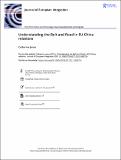Files in this item
Understanding the Belt and Road in EU-China relations
Item metadata
| dc.contributor.author | Jones, Catherine | |
| dc.date.accessioned | 2021-11-09T13:30:01Z | |
| dc.date.available | 2021-11-09T13:30:01Z | |
| dc.date.issued | 2021 | |
| dc.identifier | 276053621 | |
| dc.identifier | 542fd05e-3b3e-4c88-9202-d480e44b2324 | |
| dc.identifier | 85118654788 | |
| dc.identifier | 000716360700001 | |
| dc.identifier.citation | Jones , C 2021 , ' Understanding the Belt and Road in EU-China relations ' , Journal of European Integration , vol. 43 , no. 7 , pp. 915-921 . https://doi.org/10.1080/07036337.2021.1985764 | en |
| dc.identifier.issn | 0703-6337 | |
| dc.identifier.uri | https://hdl.handle.net/10023/24299 | |
| dc.description.abstract | China has a strategic narrative for its engagement with the EU. But the EU has neither a strategy nor a common narrative for its relations with China. This asymmetry of approach opens up opportunities for China to expose and utilise differences between EU member states, their interests and their preferences, and EU institutions, in order to present a challenge to the current liberal international order. However, although some authors see this loop-sided relationship as a clear and unambiguous challenge, it does continue to present a multitude of challenges for China in implementing its approach. More fundamentally, it reveals the lack of coherence in their current construction and understanding of the international order. | |
| dc.format.extent | 7 | |
| dc.format.extent | 555111 | |
| dc.language.iso | eng | |
| dc.relation.ispartof | Journal of European Integration | en |
| dc.subject | JZ International relations | en |
| dc.subject.lcc | JZ | en |
| dc.title | Understanding the Belt and Road in EU-China relations | en |
| dc.type | Journal item | en |
| dc.contributor.institution | University of St Andrews. School of International Relations | en |
| dc.identifier.doi | https://doi.org/10.1080/07036337.2021.1985764 | |
| dc.description.status | Peer reviewed | en |
This item appears in the following Collection(s)
Items in the St Andrews Research Repository are protected by copyright, with all rights reserved, unless otherwise indicated.

